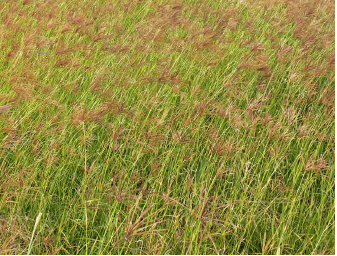Going troppo: sowing warm-season pastures
06 Oct 2021
 PRODUCTION ADVICE - OCTOBER 2021 - AGRONOMY
PRODUCTION ADVICE - OCTOBER 2021 - AGRONOMY
By Janelle Jenkins
Mixed Farming Officer
M: 0427 639 947 | E: janelle.jenkins@lls.nsw.gov.au
NSW Department of Primary Industries (DPI) recently ran a webinar discussing the use of tropical grasses in southern and central NSW (see link below). There has been increased interest in growing tropical grasses in this area, and some of the species attracting attention are digit grass, various bluegrasses, Rhodes grass, various panic grasses and purple pigeon grass. This interest comes from the fact that these grasses can grow in areas less suited to lucerne, such as on acid or poor-fertility soils, and will still provide green feed in summer. The other attractive feature of many of these tropical grasses (known as C4 grasses) is that once established, many are quite drought-tolerant.
 Left: Rhodes grass (photo courtesy NSW DPI).
Left: Rhodes grass (photo courtesy NSW DPI).
Planning and preparation pre-sowing are extremely important when growing tropical grasses. Like many perennial grasses, temperate or tropical, establishment can be tricky, as perennial seedlings are not as vigorous as annual species. This means they can often get swamped by annual weeds/grasses during this establishment phase.
Another establishment issue in the south is that summer rainfall is less predictable and reliable than in the north. Again, this means that planning and preparation are vital. It is important to choose a year that promises good spring and summer rainfall, such as this year. One way farmers can reduce the effects of rainfall unpredictability is by storing soil moisture in the year prior to sowing by using a spray fallow and keeping the paddock weed-free.
Standing stubble cover, when sowing into a previous crop, can help to conserve soil moisture by reducing surface evaporation. However, this can also be a double-edged sword as stubble cover can also result in decreased soil temperatures, making late frosts more severe.
Following are the NSW DPI’s ‘Top tips for establishing tropical grasses’:
- Species selection - Choose species that suit your paddock’s soil type and pH. Some species prefer sandy soils, i.e. digit grass, while others do better in heavy clay soils, i.e. purple pigeon grass.
- Seed quality – Tropical grass seed generally has variable viability. You need to know how viable your seed is so you can vary the sowing rate to suit. It is important to get a current seed test certificate when buying seed. Also be aware that tropical grass seed can have staggered germination, with new plants emerging well after sowing.
- Pre-sowing weed control – It is vital to have good weed control for the 2-3 years prior to sowing tropical grasses. Often this is achieved by a cropping phase that has been kept clean of weeds.
- Subsoil moisture – Try to accumulate soil moisture in the year prior to sowing to help with future seedling survival. This may be achieved by early removal of forage crops pre-sowing.
- Ground cover – The retention of crop residue can help reduce soil moisture losses and reduce temperature fluctuation at the soil surface. But be aware that this can also increase the severity of late-occurring frosts.
- Sowing methods – Regardless of the method chosen for sowing - tined or disc - it is important to get good seed-soil contact without burying the seed too deep. Seed placement should be at least 10mm deep.
- Sowing time – The best time to sow tropical grasses is when daytime temperatures are above 20oC and the night times are above 10oC for 7-10 days. The work NSW DPI has done with tropical grasses at Wagga Wagga suggests the sowing window is from mid-October/early November until April. However, they suggest that it is better to sow earlier in the window to get maximum benefit from stored soil moisture to allow maximum emergence and future seedling survival. But beware that going either very early or late in the sowing window increases the risk of the new plants being impacted by late or early frosts. Once the grasses are established, they are much more frost-tolerant.
More work is still needed in this space. Some issues that still need more investigation include: what companion species/legumes work well in tropical grass mixes; how the tropicals might fit into southern rotations; and the best sowing time for each locality.
To this end, the Holbrook Landcare Network (HLN) has successfully applied to Meat and Livestock Australia to undertake a producer demonstration sites (PDS) project, which will start shortly. HLN will work with local farmers who are trialling tropical grasses. For more information, contact HLN on 02 6036 3181. The information from this PDS project will help answer some of the questions for the local area.
Link to Tropical Grass Webinar: Tropical grass webinar - YouTube
Link to NSW DPI Tropical Grass Book: BOOK Tropical perennial grasses for northern inland NSW